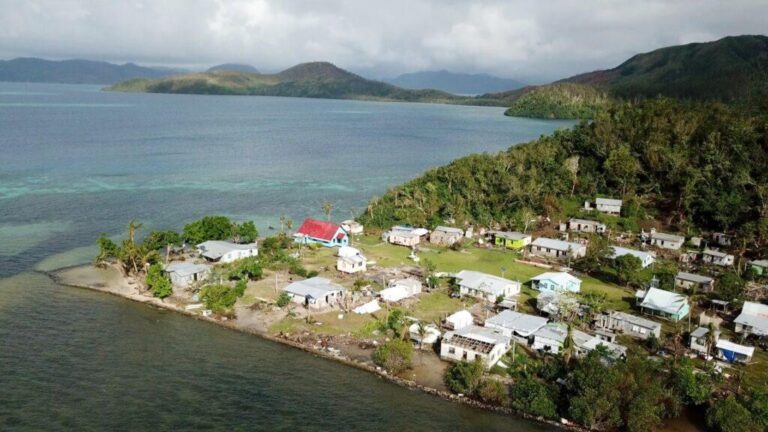As rising seas and relentless coastal erosion threaten the very existence of their community, residents of France’s last outpost in North America are undertaking an extraordinary effort: moving an entire village. Located on the remote ĂŽle Saint-Pierre off the coast of Newfoundland, this small French territory faces mounting environmental challenges that have forced its inhabitants to confront a daunting question-how do you move a village? This article explores the urgent struggle of a community determined to outrun the sea, preserving their unique heritage against the encroaching tides.
Challenges Facing France’s Last North American Village Amid Rising Sea Levels
Nestled on the edge of the Atlantic, this isolated community confronts an existential threat as the relentless rise of sea levels encroaches upon its very foundations. For decades, residents have witnessed their homes and historic landmarks succumb to the increasingly frequent storm surges and coastal erosion. Local infrastructure struggles to cope with flooding that now occurs multiple times a year, complicating access to essential services and threatening traditional ways of life that have persisted since the village’s founding.
Efforts to safeguard the village hinge not only on engineering and environmental strategies but also on a deeply human battle to preserve cultural identity. Among the critical challenges are:
- Limited funding for large-scale relocation or protective barriers.
- Environmental regulations that restrict construction and land modifications.
- Logistical obstacles in moving entire families and community institutions.
- Preserving heritage while adapting to modern realities.
| Issue | Impact | Current Response |
|---|---|---|
| Coastal Erosion | Loss of land & homes | Reinforced seawalls |
| Flooding Frequency | Disrupted transportation | Elevated roads |
| Population Decline | Reduced workforce | Community incentives |
Community Efforts and Innovative Strategies to Preserve Heritage and Homes
In the face of relentless coastal erosion and rising sea levels, the residents of this historic village have embarked on a remarkable journey to safeguard their homes and heritage. Local associations, backed by government initiatives, are spearheading restoration projects that blend traditional building techniques with cutting-edge engineering. From elevating structures on stilts to reinforcing riverbanks with natural barriers, these strategies aim not just to protect but to preserve the identity embedded in generations of local architecture.
The community’s approach is as much about cultural resilience as it is about physical preservation. Workshops educate locals on sustainable materials and flood-resistant design, fostering a strong sense of ownership. Here’s a snapshot of key initiatives shaping the village’s future:
- Building Elevation: Raising homes above projected flood levels.
- Living Shorelines: Using vegetation and biodegradable materials to stabilize coasts.
- Heritage Workshops: Teaching traditional skills to maintain historic aesthetics.
- Community Mapping: Documenting vulnerable sites through participatory surveys.
| Strategy | Purpose | Status |
|---|---|---|
| Flood-resilient Foundations | Prevent structural damage during high tides | Implemented in 60% of homes |
| Community-led Shoreline Planting | Reduce soil erosion and enhance biodiversity | Ongoing, with seasonal volunteer drives |
| Heritage Building Grants | Fund repairs that respect historical design | Active, supporting 15 families |
Expert Recommendations for Sustainable Relocation and Climate Adaptation
In tackling the challenges of relocating an entire community, experts emphasize the importance of integrating local knowledge with cutting-edge environmental science. This hybrid approach ensures that adaptation strategies are both practical and resilient. For the villagers confronting the encroaching sea, measures such as reinforcing natural barriers, adopting climate-resilient infrastructure, and preserving cultural heritage during the transition are vital. Moreover, collaborative governance-bringing together residents, environmentalists, and policymakers-fosters a shared sense of ownership and commitment throughout the relocation process.
Experts also highlight several critical factors for successful relocation:
- Early Community Engagement: Prioritize transparent dialogue to address fears and aspirations.
- Flexible Land Use Planning: Adapt zoning and resource allocation as environmental conditions evolve.
- Investment in Infrastructure: Build homes and public spaces designed for future climate realities.
- Economic Diversification: Encourage sustainable livelihoods to reduce vulnerability.
| Recommendation | Key Benefit | Example |
|---|---|---|
| Preserving Wetlands | Natural Flood Defense | Planting Mangroves |
| Community-Led Design | Cultural Continuity | Participatory Mapping |
| Renewable Energy Integration | Reduced Carbon Footprint | Solar-Powered Facilities |
In Conclusion
As rising seas continue to threaten coastal communities worldwide, the struggle of the residents in France’s last North American outpost highlights a growing global dilemma. Their determination to relocate an entire village underscores the complexity and urgency of adapting to climate change’s relentless advance. While the future remains uncertain, this small community’s efforts serve as a poignant reminder of the human cost behind environmental shifts and the pressing need for coordinated action to protect vulnerable populations.




